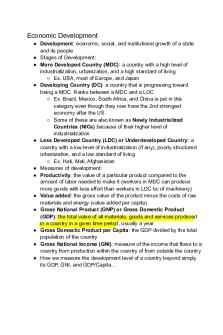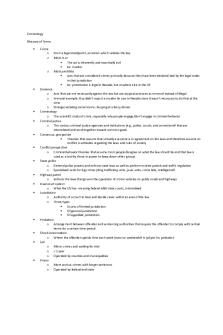Geography Unit 3 Glossary PDF

| Title | Geography Unit 3 Glossary |
|---|---|
| Author | Chloe Miles |
| Course | Geography |
| Institution | Victorian Certificate of Education |
| Pages | 3 |
| File Size | 108.7 KB |
| File Type | |
| Total Downloads | 56 |
| Total Views | 142 |
Summary
geography unit 3 vce glossary...
Description
Geography Glossary UNIT 3 AREA OF STUDY 1- DEFORESTATION Word Geographic characteristics
PQE method SHEEPT method
BOLTSS SALTS Eastings Northings Latitude Longitude Change
Distance
Distribution movement Place
Process Region
Scale
Definition Features and influences identified in the environment and described using spatial concepts. E.g. topography, climate and land values/uses Way to describe the patterns and trends on a map. P- pattern, Q- quantification, E- exceptions Way of describing geographic factors. S- social, H- historic, E- environmental, E-economic, Ppolitical, T- technological Should be included on every map. B- border, Oorientation, L- legend, T- title, S- scale, S- source Should be included on every graph. S- source, A- axis labelled, L- legend, T- title, S- scale Used on topographic maps are vertical lines going in the direction of left to right Used on topographic maps are horizontal lines going in the direction of bottom to the top Horizontal lines going from the top of the globe down Vertical lines going from the top of the globe right Can occur at different rates and times over varying durations and shows how something has been adapted into something else Absolute: measured in units such as metres or kilometres Relative: length of time from one place to another The arrangement of phenomena on space or time The change or expansion in location of phenomena from original location to a new one Absolute location refers to a places specific point and the relative location refers to a places distance from one place to another An identifiable series of actions leading to change or preservation of phenomena A definable are of the Earth’s surface that contains one or more common characteristic that distinguish it from neighboring areas Relationship on a map between measurements and actual measurements on the ground
Spatial association Sustainability Land cover
Biome Cultivation Preservation Climate change Geophysical
Plant succession
Deforestation Forest
Primary forests Secondary forests
Plantations
Tropical forests Subtropical forests
Temperate forests Boreal forests Holocene Climatic Optimum
Last Glacial Maximum
Degree to which 2 or more phenomena are similarly arranged over space The capacity of the environment to continue to support and sustain life Natural state of the biophysical environment developed over time as a result of the interconnection between climate, landforms and human activity A large naturally occurring community of flora and fauna occupying a major habitat Growing crops on land Preserving the earth’s natural state and resources for prolonged use The change in the Earth’s climate, predominantly getting warmer as time goes on The ways the distribution of the Earth’s landmasses have changed by volcanic activity, earthquakes and landslides The successful growth of a plant species in a particular are due to the presence of other plants, light, space and water The long term reduction of tree canopy cover to below 10-30% of its original cover Natural land cover covering at least a hectare dominated by trees having a height of 5 meters and a 10% crown cover Forests that remain virtually in their naturally condition, with a full array of native species Forests that consist of native species but have been disturbed by human activities or their development (replantation) forests that are a monoculture of native and non-native trees planted for commercial production of a particular species Occur near the equator, rainy and dry seasons, humid climate, thick canopy Found close to the equator, high levels of rainfall, warm temperatures, experience tropical summers and also winters Warm and cold temperatures, 4 seasons Conifer/pine forests, winters cold and long, summers short and cool, snow Time period epoch occurred 8,000 years ago which has average increases of upto 4C near the north pole, with sea levels rising upto 3 metres due to a high amount of rainfall Time period which occurred 20,000 years ago when the earth was much colder and reached glacial maximum. The earth was 3-5C cooler than the present day and the sea level was 125 metres less than present day. When
Clear-felling Selection Group selection Shelter wood seed-tree retention Fragmentation Afforestation Monoculture Reforestation Net forest change
deglaciation occurred. The sea levels rose. All vegetation cleared and no conservation taken into account Selected trees are felled and understorey remains intact A section of the forest is completely cleared Only mature trees felled Most trees are removed but some are left tonto reduce environmental impacts Some clearing of pockets of forest occurs Act of trees planted by humans on land that was not previously forested The cultivation of a single crop on land Refers to post-logging activities through seeding or replanting The total change in an area of land with forest...
Similar Free PDFs

Geography Unit 3 Glossary
- 3 Pages

Sandhu 3 geography 10
- 3 Pages

Geography Assignment 3
- 5 Pages

Glossary
- 2 Pages

Glossary
- 2 Pages

Human geography test 3 review
- 10 Pages

Unit 3 homework - unit 3
- 4 Pages

Criminology glossary
- 5 Pages
Popular Institutions
- Tinajero National High School - Annex
- Politeknik Caltex Riau
- Yokohama City University
- SGT University
- University of Al-Qadisiyah
- Divine Word College of Vigan
- Techniek College Rotterdam
- Universidade de Santiago
- Universiti Teknologi MARA Cawangan Johor Kampus Pasir Gudang
- Poltekkes Kemenkes Yogyakarta
- Baguio City National High School
- Colegio san marcos
- preparatoria uno
- Centro de Bachillerato Tecnológico Industrial y de Servicios No. 107
- Dalian Maritime University
- Quang Trung Secondary School
- Colegio Tecnológico en Informática
- Corporación Regional de Educación Superior
- Grupo CEDVA
- Dar Al Uloom University
- Centro de Estudios Preuniversitarios de la Universidad Nacional de Ingeniería
- 上智大学
- Aakash International School, Nuna Majara
- San Felipe Neri Catholic School
- Kang Chiao International School - New Taipei City
- Misamis Occidental National High School
- Institución Educativa Escuela Normal Juan Ladrilleros
- Kolehiyo ng Pantukan
- Batanes State College
- Instituto Continental
- Sekolah Menengah Kejuruan Kesehatan Kaltara (Tarakan)
- Colegio de La Inmaculada Concepcion - Cebu







